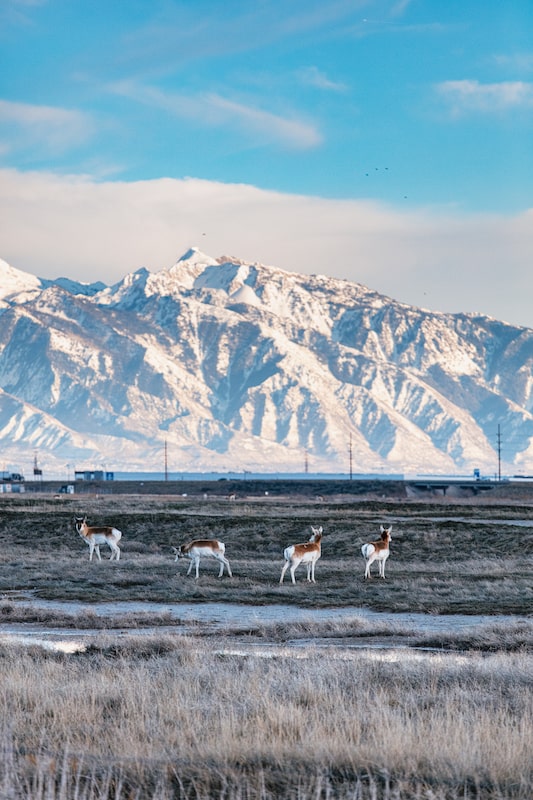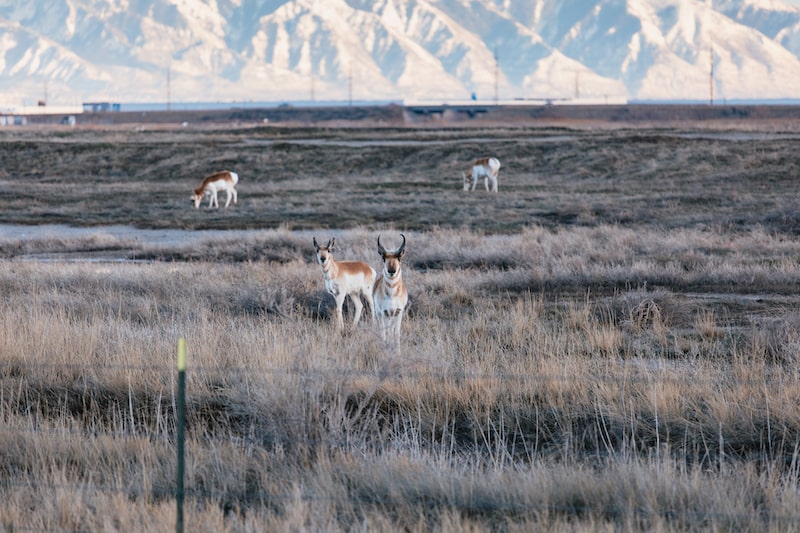
Pronghorns prance just North of I-80.
Have you seen Salt Lake City’s pronghorn antelope?
Most Utahns do not know that our capital city may be the only one in America that has its own herd of native pronghorn antelope inside its city limits. I know of no other US city where these magnificent big game animals can be routinely seen just off a major freeway only minutes outside of downtown.
As the only native goat on our continent, the American antelope, Antilocapra americana, is best recognized worldwide for its great sustained running speed. With the ability to run at 30 mph for 15 miles, they can spurt to 70 mph to escape danger. I once had a herd, including youngsters, pass my truck in the west desert, then cross the asphalt road in front of me while I was driving 55 mph.
They also possess ‘binocular vision’, enabling them to spot us at greater distances, and are well known for their curiosity. One younger buck in the herd actually approached me, only to run off later when my dog tried fruitlessly to chase it.
Around the turn of the century, populations of both America’s bison and pronghorn were very low, but Utah State Parks and Recreation agreed to protect both threatened species on Antelope Island State Park.
Special limited entry hunts are conducted by the Utah Division of Wildlife Resources to help manage those populations, along with some trophy mule deer that are also found there.
As a meat-hunter, I harvested my first antelope after waiting five years to finally draw a permit for the Flaming Gorge Reservoir area. The meat was excellent.

Buck pronghorns drop their black curved ‘horns’ during the winter, similar to mule deer dropping their antlers. However, the two species are not related. Over many decades, both antelope and mule deer have migrated from Antelope Island to the mainland in Weber and Davis Counties, and south to the northern end of Salt Lake County.
Although I have seen large trophy-size pronghorns within city limits, a few of the island’s famous trophy mule deer have also migrated across, but have often been illegally harvested for their antlers (see photo).
Because Great Salt Lake water levels were higher in the past, these animals originally swam or waded to the mainland. With the current, extremely low lake levels, however, they can simply cross on open ground.
Finding good feeding opportunities with little hunting pressure, the herd has grown to about 80 animals in what has become the Inland Port area. I routinely see groups of them just west of the International Center and Amazon and just north of I-80.
Like many other wildlife species over the decades, antelope have continued to adapt to human activities, referred to as “habituation”, and have grown more accustomed to the development of warehouses, a new state prison, and continued use by the numerous duck clubs to the north. The herds are easy to spot due to their contrasting reddish-brown and white bodies.
I recommend looking north while traveling west on I-80 just outside of SLC’s downtown for this great, watchable-wildlife opportunity.
How cool is that?

